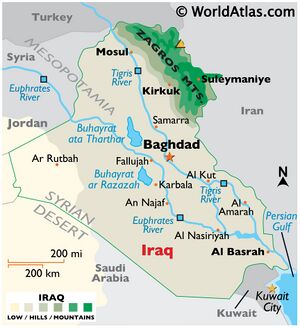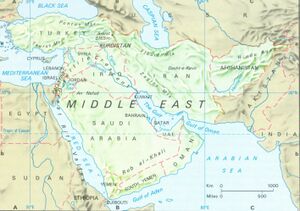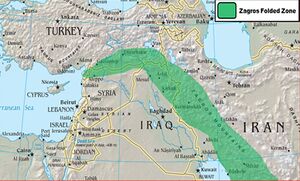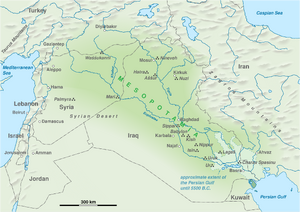Mesopotamia
| Author:Laxman Burdak, IFS (R) |
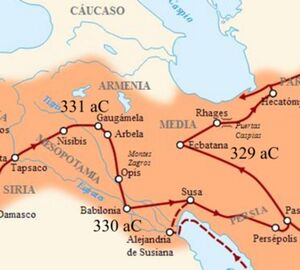
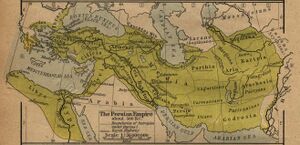
Mesopotamia (मेसोपोटामिया) is a name for the area of the Tigris–Euphrates river system, corresponding to modern-day Iraq, the northeastern section of Syria and to a much lesser extent southeastern Turkey, smaller parts of southwestern Iran and Kuwait.
Contents
Varoiants
- Mesopotamia (Anabasis by Arrian, p. 153, 156, 161, 172, 308, 380, 385.)
Origin of name
The regional toponym Mesopotamia comes from the ancient Greek root words μέσος (meso) "middle" and ποταμός (potamia) "river" and literally means "(Land) between rivers".
History
Widely considered to be the cradle of civilization in the West, Bronze Age Mesopotamia included Sumer and the Akkadian, Babylonian, and Assyrian empires, all native to the territory of modern-day Iraq. In the Iron Age, it was controlled by the Neo-Assyrian and Neo-Babylonian empires. The indigenous Sumerians and Akkadians (including Assyrians and Babylonians) dominated Mesopotamia from the beginning of written history (c. 3100 BC) to the fall of Babylon in 539 BC, when it was conquered by the Achaemenid Empire. It fell to Alexander the Great in 332 BC, and after his death, it became part of the Greek Seleucid Empire.
Around 150 BC, Mesopotamia was under the control of the Parthians. Mesopotamia became a battleground between the Romans and Parthians, with parts of Mesopotamia coming under ephemeral Roman control. In AD 226, it fell to the Sassanid Persians and remained under Persian rule until the 7th-century Arab Islamic conquest of the Sassanid Empire. A number of primarily neo Assyrian and Christian native Mesopotamian states existed between the 1st century BC and 3rd century AD, including Adiabene, Osroene, and Hatra.
The pre-history of the Ancient Near East begins in the Lower Paleolithic period, but writing began with a pictographic script in the Uruk IV period (ca. 4th millennium BC), and the documented record of actual historical events — and the ancient history of lower Mesopotamia — commence in the mid-third millennium BC with cuneiform records of early dynastic kings, and ends with either the arrival of the Achaemenid Empire in the late 6th century BC, or with the Arab Islamic conquest of Mesopotamia and the establishment of the Caliphate in the late 7th century AD, from which point the region came to be known as Iraq. During this period Mesopotamia housed some of the world's most ancient highly developed and socially complex states. The region was one of the four riverine civilizations where writing was invented, along with the Nile valley in Egypt, the Indus Valley in the Indian subcontinent, and Yellow River valley in China. Mesopotamia housed historically important cities such as Uruk, Nippur, Nineveh, Assur and Babylon, as well as major territorial states such as the city of Eridu, the Akkadian kingdom, the Third Dynasty of Ur, and the various Assyrian empires. Some of the important historical Mesopotamian leaders were Ur-Nammu (king of Ur), Sargon (who established the Akkadian Empire), Hammurabi (who established the Old Babylonian state), Ashur-uballit II and Tiglath-Pileser I (who established the Assyrian Empires).
Geography of Mesopotamia
The geography of Mesopotamia, encompassing its ethnology and history, centered on the two great rivers, the Tigris and Euphrates. While the southern is flat and marshy, the near approach of the two rivers to one another, at a spot where the undulating plateau of the north sinks suddenly into the Babylonian alluvium, tends to separate them still more completely. In the earliest recorded times, the northern portion was included in Mesopotamia; it was marked off as Assyria after the rise of the Assyrian monarchy. Apart from Assur, the original capital of Assyria, the chief cities of the country, Nineveh, Kalaḫ and Arbela, were all on the east bank of the Tigris. The reason was its abundant supply of water, whereas the great plain on the western side had to depend on streams flowing into the Euphrates.
Defining Mesopotamia: Mesopotamia means "(Land) between two rivers" in ancient Greek, referring to the land between the Tigris and Euphrates rivers, but the region can be broadly defined to include the area that is now most of Iraq, eastern Syria, southeastern Turkey.[1] The oldest known occurrence of the name Mesopotamia dates to the 4th century BCE, when it was used to designate the land east of the Euphrates in north Syria.[2] In modern times it has been more generally applied to all the lands between the Euphrates and the Tigris,thereby incorporating not only parts of Syria but also almost all of Iraq and southeastern Turkey, and parts of southwestern Iran.[3] The neighboring steppes to the west of the Euphrates and the western part of the Zagros Mountains are also often included under the wider term Mesopotamia.[4][5][6]A further distinction is usually made between Upper or Northern Mesopotamia and Lower or Southern Mesopotamia.[7] Upper Mesopotamia, also known as the Jazirah, is the area between the Euphrates and the Tigris from their sources down to Baghdad.[8] Lower Mesopotamia is the area from Baghdad to the Persian Gulf.[9] In modern scientific usage, the term Mesopotamia often also has a chronological connotation. In modern Western historiography of the region, the term "Mesopotamia" is usually used to designate the area from the beginning of time, until the Muslim conquest in the 630s, with the Arabic names Iraq and Jazirah being used to describe the region after that event.[10]
Jat History
Subedar Singha Singh Thakuran (सूबेदार सिंहासिंह ठाकुरान), from Sirohar, Mandawar Alwar, was a Social worker in Alwar, Rajasthan. He fought war in Mesopotamia and was awarded with IDSM Medal for his bravery in 1915. [11]
ठाकुर देशराज[12] ने लिखा है ....सूबेदार सिंहासिंह इस समय अलवर 'राज्य जाट क्षत्रिय संघ' के उपप्रधान हैं। आप ठाकुरान गोत्र के जाट हैं। आपके पिता का नाम चौधरी रंजीत सिंह था। संवत 1942 में आपका जन्म हुआ. आप से छोटे तीन भाई और हैं। सन् 1904 में आप फौज में भर्ती हुए। सन् 1915 में मेसोपोटामिया के रण क्षेत्र में भेजे गए। इस युद्ध में अच्छी सेवा करने के सिलसिले में आप जमादार बनाए गए। सीमा प्रांत के पठान विद्रोह को दबाने के लिए जो सेनाएं गई उनमें आप भी थे। वहां आपको सूबेदार बनाया गया और IDSM का मेडल बहादुरी में मिला। 1925 में पेंशन ले ली। तब से आप अपने गांव में रहते हैं और कौम की सेवा करते हैं। इधर जब कौमी जागृति का बिगुल बाजा आप जाट क्षत्रिय संघ में शामिल हो गए 1940 में आपने अपने यहाँ उसका दूसरा वार्षिकोत्सव मनाया।
आप पक्के समाज सुधारक हैं। ब्याह-शादियों में कम से कम खर्च करते हैं। अलवर की जाट जागृति में भरपूर हाथ बताते हैं।
Periodization
Pre- and protohistory
- Pre-Pottery Neolithic A (10,000–8700 BC)
- Pre-Pottery Neolithic B (8700–6800)
- Hassuna (~6000 bc–? BC), Samarra (~5700 BC–4900 BC) and Halaf (~6000 BC–5300 BC) cultures
- Ubaid period (~5900–4400 BC)
- Uruk period (~4400–3100 BC)
- Jemdet Nasr period (~3100–2900 BC)[13]
Early Bronze Age
- Early Dynastic period (~2900–2350 BC)
- Akkadian Empire (~2350–2100 BC)
- Ur III period (2112–2004 BC)
- Early Assyrian kingdom (24th to 18th century BC)
Middle Bronze Age
- Early Babylonia (19th to 18th century BC)
- First Babylonian Dynasty (18th to 17th century BC)
- collapse: Minoan Eruption (c. 1620 BC)
Late Bronze Age
- Middle Assyrian period (16th to 11th century BC)
- Assyrian Empire (c. 1365 BC–1076 BC)
- Kassite dynasty in Babylon, (c. 1595 BC–1155 BC)
- collapse: Bronze Age collapse (12th to 11th century BC)
Iron Age
- Neo-Hittite or Syro-Hittite regional states (11th to 7th century BC)
- Neo-Assyrian Empire (10th to 7th century BC)
- Neo-Babylonian Empire (7th to 6th century BC)
Classical Antiquity
- Persian Babylonia, Achaemenid Assyria (6th to 4th century BC)
- Seleucid Mesopotamia (4th to 3rd century BC)
- Parthian Babylonia (3rd century BC to 3rd century AD)
- Osroene (2nd century BC to 3rd century AD)
- Adiabene (1st to 2nd century AD)
- Hatra (1st to 2nd century AD)
- Roman Mesopotamia, Roman Assyria (2nd century AD)
Late Antiquity
- Persian Mesopotamia, Persian Asuristan (Assyria) (3rd to 7th century AD)
- Arab Muslim conquest of Mesopotamia (mid-7th century AD)
Mention by Pliny
Pliny[13] mentions Mesopotamia....The whole of Mesopotamia formerly belonged to the Assyrians, being covered with nothing but villages, with the exception of Babylonia1 and Ninus.2 The Macedonians formed these communities into cities, being prompted thereto by the extraordinary fertility of the soil.
1 The great seat of empire of the Babylonio-Chaldæan kingdom. It either occupied the site, it is supposed, or stood in the immediate vicinity of the tower of Babel. In the reign of Labynedus, Nabonnetus, or Bel- shazzar, it was taken by Cyrus. In the reign of Augustus, a small part only of Babylon was still inhabited, the remainder of the space within the walls being under cultivation. The ruins of Babylon are found to commence a little south of the village of Mohawill, eight miles north of Hillah.
2 Nineveh. See c. 16 of the present Book.
External links
References
- ↑ https://www.britannica.com/place/Mesopotamia-historical-region-Asia
- ↑ Finkelstein, J.J. (1962), "Mesopotamia", Journal of Near Eastern Studies, 21 (2): 73–92,
- ↑ Foster, Benjamin R.; Polinger Foster, Karen (2009), Civilizations of Ancient Iraq, Princeton: Princeton University Press, ISBN 978-0-691-13722-3,p.6
- ↑ Canard, M. (2011), "al-ḎJazīra, Ḏjazīrat Aḳūr or Iḳlīm Aḳūr", in Bearman, P.; Bianquis, Th.; Bosworth, C.E.; van Donzel, E.; Heinrichs, W.P. (eds.), Encyclopaedia of Islam, Second Edition, Leiden: Brill Online, OCLC 624382576
- ↑ Wilkinson, Tony J. (2000), "Regional Approaches to Mesopotamian Archaeology: the Contribution of Archaeological Surveys", Journal of Archaeological Research, 8 (3): 219–267, doi:10.1023/A:1009487620969, ISSN 1573-7756, S2CID 140771958, pp. 222–223
- ↑ Matthews, Roger (2003), The Archaeology of Mesopotamia. Theories and Approaches, Approaching the past, Milton Square: Routledge, ISBN 0-415-25317-9,p.5
- ↑ Miquel, A.; Brice, W.C.; Sourdel, D.; Aubin, J.; Holt, P.M.; Kelidar, A.; Blanc, H.; MacKenzie, D.N.; Pellat, Ch. (2011), "ʿIrāḳ", in Bearman, P.; Bianquis, Th.; Bosworth, C.E.; van Donzel, E.; Heinrichs, W.P. (eds.), Encyclopaedia of Islam, Second Edition, Leiden: Brill Online, OCLC 624382576
- ↑ Canard, M. (2011), "al-ḎJazīra, Ḏjazīrat Aḳūr or Iḳlīm Aḳūr", in Bearman, P.; Bianquis, Th.; Bosworth, C.E.; van Donzel, E.; Heinrichs, W.P. (eds.), Encyclopaedia of Islam, Second Edition, Leiden: Brill Online, OCLC 624382576
- ↑ Miquel et al. 2011
- ↑ Bahrani, Z. (1998), "Conjuring Mesopotamia: Imaginative Geography a World Past", in Meskell, L. (ed.), Archaeology under Fire: Nationalism, Politics and Heritage in the Eastern Mediterranean and Middle East, London: Routledge, pp. 159–174, ISBN 978-0-415-19655-0
- ↑ Thakur Deshraj:Jat Jan Sewak, 1949, p.82-83
- ↑ Thakur Deshraj:Jat Jan Sewak, 1949, p.82-83
- ↑ Natural History by Pliny Book VI/Chapter 30
